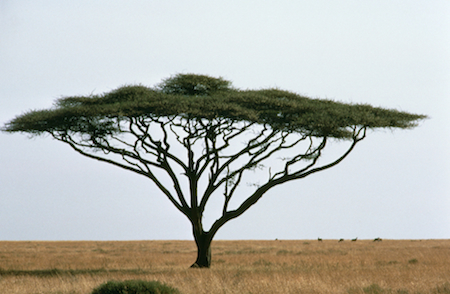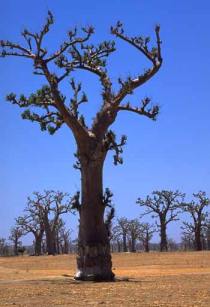The Savanna BiomeThe Savanna biome is characterized by an extensive cover of grasses with scattered trees. It is a transitional biome between those dominated by forests and those dominated by grasses. The Savanna biome is associated with climates having seasonal precipitation accompanied with a seasonal drought. A midlatitude variant, the parkland, is located in the drier portions of the humid continental climate. Tropical SavannaThe tropical savanna is generally found in regions dominated by the Wet-Dry Tropical climate. An extensive cover of tall grasses, sometimes reaching a height of 3 meters, is found in the tropical savanna. Most savanna grass is coarse and grows in tufts with intervening patches of bare ground. Scattered, individual trees or small groves of trees are common. The umbrella shaped Acacia tree is a notable species of the Savanna biome. The acacia tree uses its long tap roots draw water from deep below the surface during the dry season of the savanna. The tree's long thorns are home to small stinging ants, both of which ward off herbivorous animals. Only the giraffe can tolerate the acacia foliage. The tree's small leaves reduce water loss. Its umbrella shape maximizes the exposure of the small leaves to solar radiation.
Figure 13.* Acacia Tree The small amount of high sun rainfall in the savanna is not enough to sustain trees in the savanna biome. Other regional factors play an important role in maintaining the savanna. In eastern Africa where precipitation is higher, savanna vegetation is maintained by periodic fires. Fires burn back the forest and stimulates the growth of grasses like that which occurs in the prairie grasslands. Savannas, like those found in Venezuela and Brazil, develop on soils that have a hard crust and are subject to cracking. Trees flourish where their roots can follow the cracks down to water held deep beneath the surface. Grasses grow in the crust above.
Figure 13.16 The Baobab tree found in the Savanna of Senegal. (Source: UN/DPI Photo #187250C by Evan Schneider) Plants in the savanna have adapted to the long dry season in a number of ways. The Baobab tree stores water in its huge trunk, drawing on the moisture during periods of drought stress. Many grasses and trees of the savanna flourish during the brief wet season and then go into a state of dormancy. Grasses turn brown and trees lose their leaves to reduce the loss of water by transpiration. A number of different animal species inhabit the tropical savanna like
lions, zebras, elephants and giraffes. The long neck of the giraffe is a unique adaptation
to the savanna woodlands; its long neck permits browsing on the higher foliage of trees.
|

